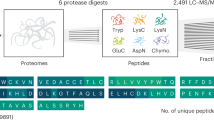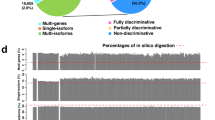Abstract
A full description of the human proteome relies on the challenging task of detecting mature and changing forms of protein molecules in the body. Large-scale proteome analysis1 has routinely involved digesting intact proteins followed by inferred protein identification using mass spectrometry2. This ‘bottom-up’ process affords a high number of identifications (not always unique to a single gene). However, complications arise from incomplete or ambiguous2 characterization of alternative splice forms, diverse modifications (for example, acetylation and methylation) and endogenous protein cleavages, especially when combinations of these create complex patterns of intact protein isoforms and species3. ‘Top-down’ interrogation of whole proteins can overcome these problems for individual proteins4,5, but has not been achieved on a proteome scale owing to the lack of intact protein fractionation methods that are well integrated with tandem mass spectrometry. Here we show, using a new four-dimensional separation system, identification of 1,043 gene products from human cells that are dispersed into more than 3,000 protein species created by post-translational modification (PTM), RNA splicing and proteolysis. The overall system produced greater than 20-fold increases in both separation power and proteome coverage, enabling the identification of proteins up to 105 kDa and those with up to 11 transmembrane helices. Many previously undetected isoforms of endogenous human proteins were mapped, including changes in multiply modified species in response to accelerated cellular ageing (senescence) induced by DNA damage. Integrated with the latest version of the Swiss-Prot database6, the data provide precise correlations to individual genes and proof-of-concept for large-scale interrogation of whole protein molecules. The technology promises to improve the link between proteomics data and complex phenotypes in basic biology and disease research7.
This is a preview of subscription content, access via your institution
Access options
Subscribe to this journal
Receive 51 print issues and online access
$199.00 per year
only $3.90 per issue
Buy this article
- Purchase on Springer Link
- Instant access to full article PDF
Prices may be subject to local taxes which are calculated during checkout




Similar content being viewed by others
Change history
07 December 2011
Acknowledgements were corrected.
References
Wisniewski, J. R., Zougman, A., Nagaraj, N. & Mann, M. Universal sample preparation method for proteome analysis. Nature Methods 6, 359–362 (2009)
Nesvizhskii, A. I. & Aebersold, R. Interpretation of shotgun proteomic data: the protein inference problem. Mol. Cell. Proteomics 4, 1419–1440 (2005)
Schluter, H., Apweiler, R., Holzhutter, H. G. & Jungblut, P. R. Finding one’s way in proteomics: a protein species nomenclature. Chem. Cent. J. 3, 11 (2009)
Boyne, M. T., Pesavento, J. J., Mizzen, C. A. & Kelleher, N. L. Precise characterization of human histories in the H2A gene family by top down mass spectrometry. J. Proteome Res. 5, 248–253 (2006)
Ge, Y., Rybakova, I. N., Xu, Q. G. & Moss, R. L. Top-down high-resolution mass spectrometry of cardiac myosin binding protein C revealed that truncation alters protein phosphorylation state. Proc. Natl Acad. Sci. USA 106, 12658–12663 (2009)
Nilsson, T. et al. Mass spectrometry in high-throughput proteomics: ready for the big time. Nature Methods 7, 681–685 (2010)
Mazur, M. T. et al. Quantitative analysis of intact apolipoproteins in human HDL by top-down differential mass spectrometry. Proc. Natl Acad. Sci. USA 107, 7728–7733 (2010)
Righetti, P. G., Castagna, A., Antonioli, P. & Boschetti, E. Prefractionation techniques in proteome analysis: the mining tools of the third millennium. Electrophoresis 26, 297–319 (2005)
Wang, H. et al. Intact-protein-based high-resolution three-dimensional quantitative analysis system for proteome profiling of biological fluids. Mol. Cell. Proteomics 4, 618–625 (2005)
Capriotti, A. L., Cavaliere, C., Foglia, P., Samperi, R. & Laganà, A. Intact protein separation by chromatographic and/or electrophoretic techniques for top-down proteomics. J. Chromatogr. A (in the press)
Gygi, S. P., Corthals, G. L., Zhang, Y., Rochon, Y. & Aebersold, R. Evaluation of two-dimensional gel electrophoresis-based proteome analysis technology. Proc. Natl Acad. Sci. USA 97, 9390–9395 (2000)
Tran, J. C. & Doucette, A. A. Multiplexed size separation of intact proteins in solution phase for mass spectrometry. Anal. Chem. 81, 6201–6209 (2009)
Tran, J. C. & Doucette, A. A. Gel-eluted liquid fraction entrapment electrophoresis: an electrophoretic method for broad molecular weight range proteome separation. Anal. Chem. 80, 1568–1573 (2008)
Lee, J. E. et al. A robust two-dimensional separation for top-down tandem mass spectrometry of the low-mass proteome. J. Am. Soc. Mass Spectrom. 20, 2183–2191 (2009)
Vellaichamy, A. et al. Size-sorting combined with improved nanocapillary liquid chromatography-mass spectrometry for identification of intact proteins up to 80 kDa. Anal. Chem. 82, 1234–1244 (2010)
Roth, M. J. et al. Precise and parallel characterization of coding polymorphisms, alternative splicing, and modifications in human proteins by mass spectrometry. Mol. Cell. Proteomics 4, 1002–1008 (2005)
Durbin, K. R. et al. Intact mass detection, interpretation, and visualization to automate top down proteomics on a large scale. Proteomics 10, 3589–3597 (2010)
Duncan, M. W., Aebersold, R. & Caprioli, R. M. The pros and cons of peptide-centric proteomics. Nature Biotechnol. 28, 659–664 (2010)
Bunger, M. K., Cargile, B. J., Ngunjiri, A., Bundy, J. L. & Stephenson, J. L. J. Automated proteomics of E. coli via top-down electron-transfer dissociation mass spectrometry. Anal. Chem. 80, 1459–1467 (2008)
Parks, B. A. et al. Top-down proteomics on a chromatographic time scale using linear ion trap fourier transform hybrid mass spectrometers. Anal. Chem. 79, 7984–7991 (2007)
Patrie, S. M. et al. Top down mass spectrometry of 60-kDa proteins from Methanosarcina acetivorans using quadrupole FTMS with automated octopole collisionally activated dissociation. Mol. Cell. Proteomics 5, 14–25 (2006)
Roth, M. J., Parks, B. A., Ferguson, J. T., Boyne, M. T. I. & Kelleher, N. L. ‘Proteotyping’: Population proteomics of human leukocytes using top down mass spectrometry. Anal. Chem. 80, 2857–2866 (2008)
Gomez, S. M., Nishio, J. N., Faull, K. F. & Whitelegge, J. P. The chloroplast grana proteome defined by intact mass measurements from liquid chromatography mass spectrometry. Mol. Cell. Proteomics 1, 46–59 (2002)
Matsuoka, S. et al. ATM and ATR substrate analysis reveals extensive protein networks responsive to DNA damage. Science 316, 1160–1166 (2007)
Roberson, R. S., Kussick, S. J., Vallieres, E., Chen, S. Y. & Wu, D. Y. Escape from therapy-induced accelerated cellular senescence in p53-null lung cancer cells and in human lung cancers. Cancer Res. 65, 2795–2803 (2005)
Yawata, T. et al. Identification of a ≦ 600-kb region on human chromosome 1q42.3 inducing cellular senescence. Oncogene 22, 281–290 (2003)
Sgarra, R. et al. During apoptosis of tumor cells HMGA1a protein undergoes methylation: identification of the modification site by mass spectrometry. Biochemistry 42, 3575–3585 (2003)
Sgarra, R. et al. The AT-hook of the chromatin architectural transcription factor high mobility group A1a is arginine-methylated by protein arginine methyltransferase 6. J. Biol. Chem. 281, 3764–3772 (2006)
Narita, M. et al. A novel role for high-mobility group A proteins in cellular senescence and heterochromatin formation. Cell 126, 503–514 (2006)
Service, R. F. Proteomics ponders prime time. Science 321, 1758–1761 (2008)
Soubeyrand, S., Pope, L. & Hache, R. J. G. Topoisomerase II α-dependent induction of a persistent DNA damage response in response to transient etoposide exposure. Mol. Oncol. 4, 38–51 (2010)
Serrano, M., Lin, A. W., McCurrach, M. E., Beach, D. & Lowe, S. W. Oncogenic ras provokes premature cell senescence associated with accumulation of p53 and p16(INK4a). Cell 88, 593–602 (1997)
Trinkle-Mulcahy, L. et al. Identifying specific protein interaction partners using quantitative mass spectrometry and bead proteomes. J. Cell Biol. 183, 223–239 (2008)
Tran, J. C. & Doucette, A. A. Rapid and effective focusing in a carrier ampholyte solution isoelectric focusing system: a proteome prefractionation tool. J. Proteome Res. 7, 1761–1766 (2008)
Laemmli, U. K. Cleavage of structural proteins during the assembly of the head of Bacteriopage T4. Nature 227, 680–685 (1970)
Wessel, D. & Flugge, U. I. A Method for the Quantitative recovery of protein in dilute solution in the presence of detergents and lipids. Anal. Biochem. 138, 141–143 (1984)
Cox, B. & Emili, A. Tissue subcellular fractionation and protein extraction for use in mass-spectrometry-based proteomics. Nature Protocols 1, 1872–1878 (2006)
Horn, D. M., Zubarev, R. A. & McLafferty, F. W. Automated reduction and interpretation of high resolution electrospray mass spectra of large molecules. J. Am. Soc. Mass Spectrom. 11, 320–332 (2000)
Boyne, M. T. et al. Tandem mass spectrometry with ultrahigh mass accuracy clarifies peptide identification by database retrieval. J. Proteome Res. 8, 374–379 (2009)
LeDuc, R. D. et al. ProSight PTM: an integrated environment for protein identification and characterization by top-down mass spectrometry. Nucleic Acids Res. 32, W340–W345 (2004)
Zamdborg, L. et al. ProSight PTM 2.0: improved protein identification and characterization for top down mass spectrometry. Nucleic Acids Res. 35, W701–W706 (2007)
Papadopoulos, P. M., Katz, M. J. & Bruno, G. in Proc. 3rd IEEE Int. Conf.. Cluster Computing 258 〈http://www.computer.org/portal/web/csdl/doi/10.1109/CLUSTR.2001.959986〉 (2001)
Meng, F. Y. et al. Informatics and multiplexing of intact protein identification in bacteria and the archaea. Nature Biotechnol. 19, 952–957 (2001)
Benjamini, Y. & Hochberg, Y. Controlling the false discovery rate – a practical and powerful approach to multiple testing. J. R. Stat. Soc. B 57, 289–300 (1995)
Storey, J. D. & Tibshirani, R. Statistical significance for genomewide studies. Proc. Natl Acad. Sci. USA 100, 9440–9445 (2003)
Elias, J. E. & Gygi, S. P. Target-decoy search strategy for increased confidence in large-scale protein identifications by mass spectrometry. Nature Methods 4, 207–214 (2007)
Reiter, L. et al. Protein identification false discovery rates for very large proteomics data sets generated by tandem mass spectrometry. Mol. Cell. Proteomics 8, 2405–2417 (2009)
Acknowledgements
We thank all members of the group who contributed to development of top-down mass spectrometry over the years along with several private foundations: The Searle Scholars Program, The Burroughs Wellcome Fund, The David and Lucile Packard Foundation, The Richard and Camille Dreyfus Foundation, and The Chicago Biomedical Consortium with support from The Searle Funds at The Chicago Community Trust. We further acknowledge the Department of Chemistry at the University of Illinois, the Neuroproteomics Center on Cell to Cell Signaling supported through the National Institute on Drug Abuse (P30DA 018310), the National Institute for General Medical Sciences (GM 067193-08) and the National Science Foundation (DMS 0800631), whose combined investment in basic research over the past decade made this work possible. We dedicate this work in memory of Jonathan Widom.
Author information
Authors and Affiliations
Contributions
Project design: J.C.T., L.Z., P.M.T., N.L.K. Cell culture and biology: J.C.T., J.E.L., A.D.C., D.R.A., M.L., C.W., S.M.M.S., N.S. Separations: J.C.T., J.E.L., A.D.C., D.R.A. Mass spectrometry: J.C.T., J.E.L., A.D.C., D.R.A., J.D.T., A.V., J.F.K., P.D.C. Data analysis and statistics: J.C.T., L.Z., K.R.D., B.P.E., R.D.L., P.M.T., N.L.K. Writing: J.C.T., N.L.K.
Corresponding author
Ethics declarations
Competing interests
Some components of the separations and software (ProSight) are available commercially.
Supplementary information
Supplementary Information
The file contains Supplementary Text, Supplementary References and Supplementary Figures 1-14 with legends. (PDF 1536 kb)
Supplementary Tables
This file contains Supplementary Tables 1-8 with detailed reports on protein identifications. (XLS 1653 kb)
Rights and permissions
About this article
Cite this article
Tran, J., Zamdborg, L., Ahlf, D. et al. Mapping intact protein isoforms in discovery mode using top-down proteomics. Nature 480, 254–258 (2011). https://doi.org/10.1038/nature10575
Received:
Accepted:
Published:
Issue Date:
DOI: https://doi.org/10.1038/nature10575
This article is cited by
-
Deep thermal profiling for detection of functional proteoform groups
Nature Chemical Biology (2023)
-
Structure and dynamics of endogenous cardiac troponin complex in human heart tissue captured by native nanoproteomics
Nature Communications (2023)
-
Pilot investigation of magnetic nanoparticle–based immobilized metal affinity chromatography for efficient enrichment of phosphoproteoforms for mass spectrometry–based top-down proteomics
Analytical and Bioanalytical Chemistry (2023)
-
Characterization of nanoparticles-based vaccines for COVID-19
Nature Nanotechnology (2022)
-
Atypical activation of signaling downstream of inactivated Bcr-Abl mediates chemoresistance in chronic myeloid leukemia
Journal of Cell Communication and Signaling (2022)
Comments
By submitting a comment you agree to abide by our Terms and Community Guidelines. If you find something abusive or that does not comply with our terms or guidelines please flag it as inappropriate.



